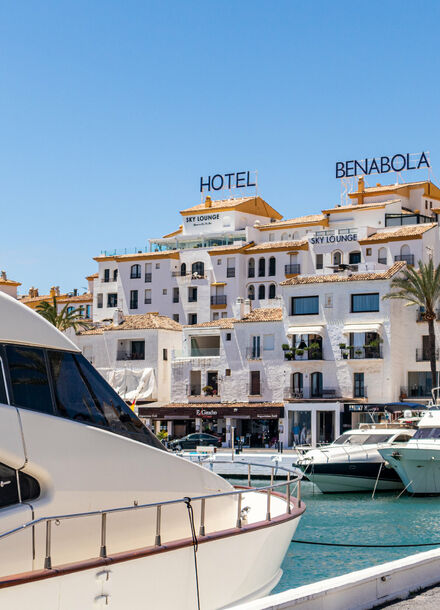Located west of the Costa del Sol, between Malaga and Estepona facing south towards the Mediterranean, behind it is the Seirra Blanca, whose highest peak is at 1200m.
Is one of the most famous seaside resorts and has a reputation as one of the most glamorous holiday destinations in southern Europe. Discovered by the world's jet set in the 1960s, Marbella stands for luxury and high-end experiences.
Marbella has 29 kilometres of beaches and an excellent climate. On sunny days, those beaches are therefore quite full, and those who can afford it live in a luxury house overlooking the sea. The coast has always been a favourite spot.
History
Several places in and around the city show that people lived there centuries ago. Along the coast there are several watchtowers that were meant to protect the interior and the city itself from invaders. According to archaeologists, the Phoenicians were the first inhabitants of the Costa del SOl and also lived where Marbella is today. But the city's history only really begins in the time of the Romans. They called the city Salduba, city of salt. Of this, the Baños Romanos and the Villa Romano del Rio Verde remain. The Arabs took over the city in the sixth century AD and changed the name to Marbil-la. They built a fort on the site where the city centre is now, to protect themselves from attacks by Christians. the Arabs ruled the city for nine centuries and were eventually expelled, like the rest of Andalusia, in 1485.
King Ferdinand's vassals took possession of the city and demolished many parts of the settlement and fortress to make way for a square, today's Plaza de los Naranjos. The new inhabitants also had to be protected from raids from the sea. It was decided to build a new fortress, the Fuente de San Luis. However, this did not offer enough protection because during the war with the French (1808-1842), only the towers remained standing.
Traditionally, Marbella has always been a fishing village and vegetables and fruit were grown on the land bordering the coast. In fact, the hinterland is rich in all kinds of minerals so a group of entrepreneurs decided to tackle the mining industry in 1826. In 1957, a huge tower for a cable car, El Cable, was built off the coast. Iron ore was thus loaded directly into cargo ships.
Marbella also owes its fame to very important celebrities such as Prince Alfondo of Hohenlone who was on a trip on the southern coast of Spain in 1940 and when he suffered engine trouble with his Rolls Royce near Marbella . The history of the town was changed forever . He fell in love with the place and decided to buy the Finca where he was waiting for help. Since Alfonso belonged to the European nobility, other celebrities liked to come too and in 1954 he opened the first hotel in town : Marbella Club Hotel, on the Golden Mile that still exists . He bought up several pieces of land to build hotels and residences such as Puerto Banus which subsequently attracted even more famous film stars, nobility and politicians to holiday.
'The very rich'
Fahd bin Abdul Aziz al-Saud the former king of Saudi Arabia had a palace built on the Golden Mile in the 1970s. Only then did the people of Marbella really notice what luxury was. The palace employed hundreds of people all year round so that everything was always spotless. As soon as the royal family went on holiday, the number of staff increased considerably and Marbella benefited from this, with good salaries and even better tips.
Over the years, Marbella became a fashionable city with its residential areas such as Siera Blanca , Nueva Andalucia , Nagueles , Golden Mile , Cascada de Camojan , Bahia de Marbella , New Golden Mile. Here attention was paid to splendour of new architecture with preference close to the beautiful Golf Courses.
